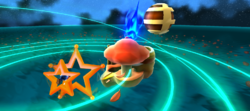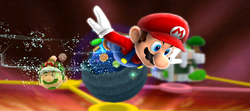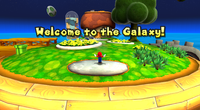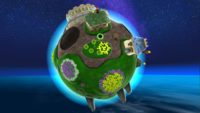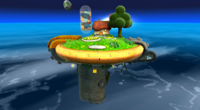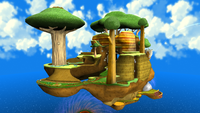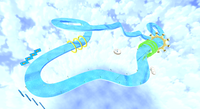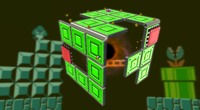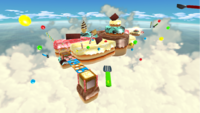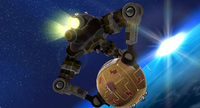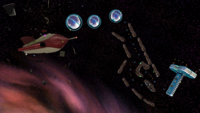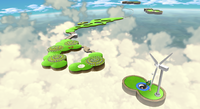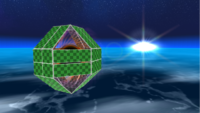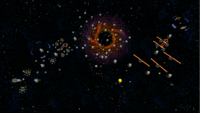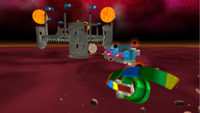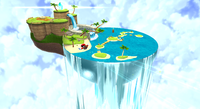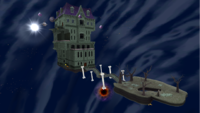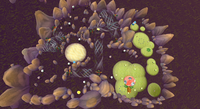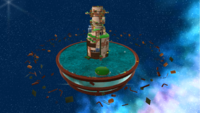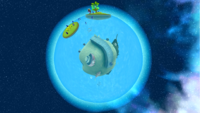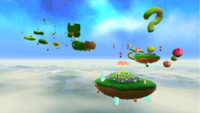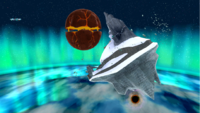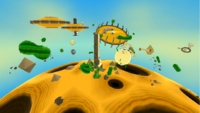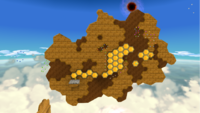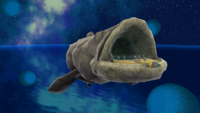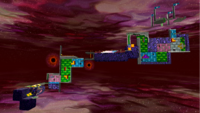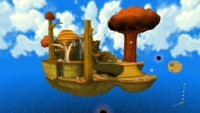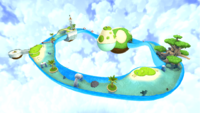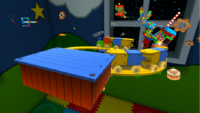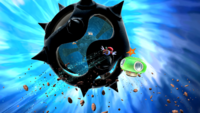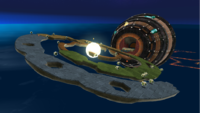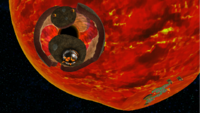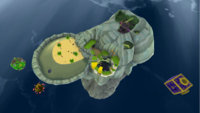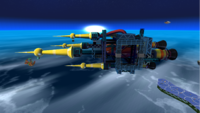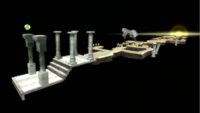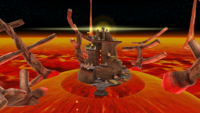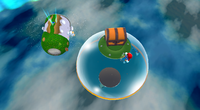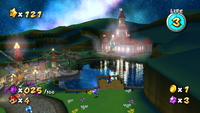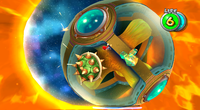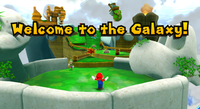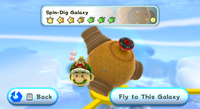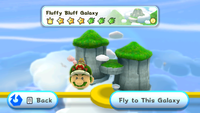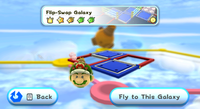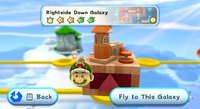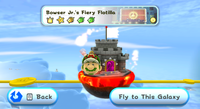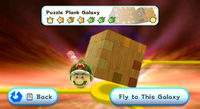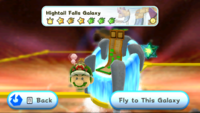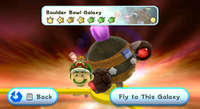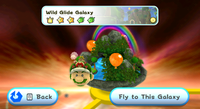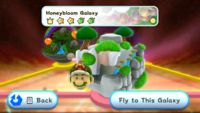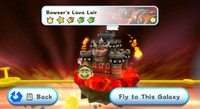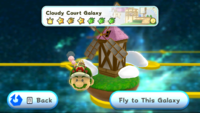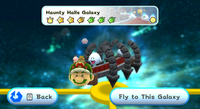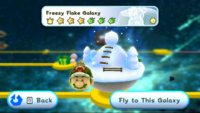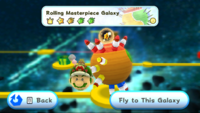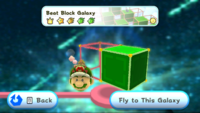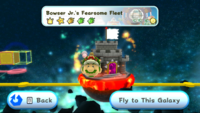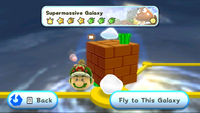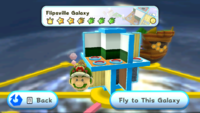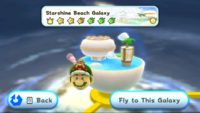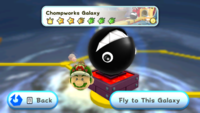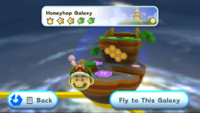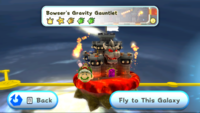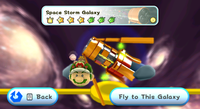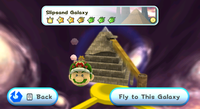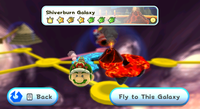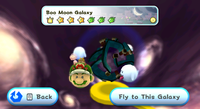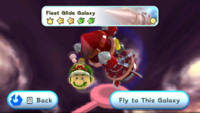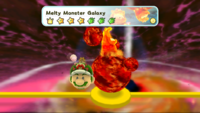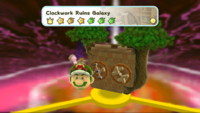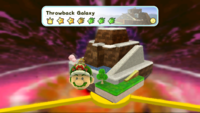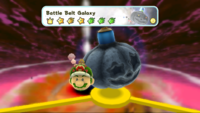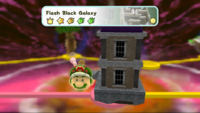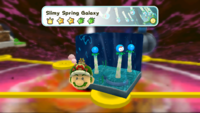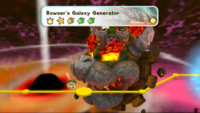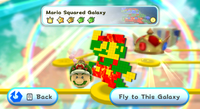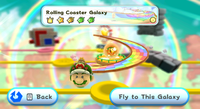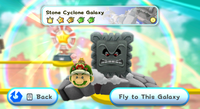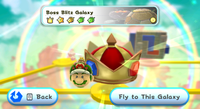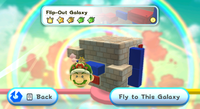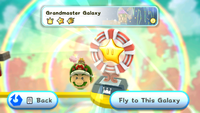Galaxy: Difference between revisions
m (Text replacement - "== *Trivia *==" to "==Notes==") |
|||
| (19 intermediate revisions by 10 users not shown) | |||
| Line 6: | Line 6: | ||
|image1=GoldLeafCosmic.png | |image1=GoldLeafCosmic.png | ||
|image2=Marioflytogalaxy.png | |image2=Marioflytogalaxy.png | ||
|caption1=[[Mario]] | |caption1=[[Mario]] about to fly to the [[Gold Leaf Galaxy]] with the use of a [[Launch Star]] | ||
|footer=[[Mario]] flying to the [[Cosmic Cove Galaxy]] in ''[[Super Mario Galaxy 2]]'' | |footer=[[Mario]] flying to the [[Cosmic Cove Galaxy]] in ''[[Super Mario Galaxy 2]]'' | ||
}} | }} | ||
{{ | {{quote|Now, go and explore the universe! There are lots and lots of galaxies for [[Mario|you]] to discover!|[[Luma]]|[[Super Mario Galaxy]]}} | ||
A '''galaxy''' is a system consisting of gases, stars, planets, and [[Prankster Comet|comet]]s. [[Mario]] or [[Luigi]] visits many galaxies in their adventures through ''[[Super Mario Galaxy]]'' and ''[[Super Mario Galaxy 2]]''. There is a total of 91 different galaxies between the two games: 42 in ''Super Mario Galaxy'' and 49 in ''Super Mario Galaxy 2''. | A '''galaxy''' is a system consisting of gases, stars, planets, and [[Prankster Comet|comet]]s. [[Mario]] or [[Luigi]] visits many galaxies in their adventures through ''[[Super Mario Galaxy]]'' and ''[[Super Mario Galaxy 2]]''. There is a total of 91 different galaxies between the two games: 42 in ''Super Mario Galaxy'' and 49 in ''Super Mario Galaxy 2''. | ||
The galaxies in ''Super Mario Galaxy'' are notably much smaller than real [[wikipedia:galaxy|galaxies]], often being composed of nothing more than a few small planetoids, | The galaxies in ''Super Mario Galaxy'' are notably much smaller than real [[wikipedia:galaxy|galaxies]], often being composed of nothing more than a few small planetoids, which come in many different shapes and sizes. Smaller galaxies in the games are more comparable to systems such as the [[Wikipedia: Solar System|Solar System]]. Many of them are more akin to the size of a [[wikipedia:star cluster|star cluster]] at their largest. | ||
In ''Super Mario Galaxy'', there is clearly a size difference between galaxies. | However, in ''Super Mario Galaxy 2'', a galaxy proportionate to a real galaxy appears in the background of [[World 4 (Super Mario Galaxy 2)|World 4]], while in [[World 5 (Super Mario Galaxy 2)|World 5]], there is a galaxy {{wp|supercluster}}. There are solar systems that can be seen to make up other galaxies that determine whether it is a large or small one. | ||
In ''Super Mario Galaxy'', there is clearly a size difference between galaxies. The fifteen major galaxies, which are larger, contain six (seven in [[Battlerock Galaxy]] and [[Dusty Dune Galaxy]]) [[Power Star]]s, while the twenty-seven minor galaxies, usually with just one or two planetoids, possess only one (two in the [[Buoy Base Galaxy]] and the [[Gateway Galaxy]]). In ''Super Mario Galaxy 2'', however, this difference is not as prevalent, as each galaxy contains either two or three regular Power Stars; respectively, there are twenty-five and twenty-four of each. | |||
In ''Super Mario Galaxy'', most galaxies are observed from six different [[dome]]s onboard the [[Comet Observatory]]. These domes show the player up to five galaxies and give them the option to fly to those galaxies in order to search for Power Stars. Just outside of each dome is a [[Hungry Luma]], which transforms into an additional galaxy after the player feeds it a certain number of [[Star Bit]]s. The remaining galaxies in the game are accessed via other areas on or around the Comet Observatory, including the [[Planet of Trials]] and the [[Gate (Super Mario Galaxy)|Gate]]. In ''Super Mario Galaxy 2'', galaxies are grouped into seven different [[World]]s, each of which contains a total of seven galaxies. One Hungry Luma is encountered in each World, which transforms into a new galaxy when called to [[Starship Mario]] and fed the required number of Star Bits. | In ''Super Mario Galaxy'', most galaxies are observed from six different [[dome]]s onboard the [[Comet Observatory]]. These domes show the player up to five galaxies and give them the option to fly to those galaxies in order to search for Power Stars. Just outside of each dome is a [[Hungry Luma]], which transforms into an additional galaxy after the player feeds it a certain number of [[Star Bit]]s. The remaining galaxies in the game are accessed via other areas on or around the Comet Observatory, including the [[Planet of Trials]] and the [[Gate (Super Mario Galaxy)|Gate]]. In ''Super Mario Galaxy 2'', galaxies are grouped into seven different [[World]]s, each of which contains a total of seven galaxies. One Hungry Luma is encountered in each World, which transforms into a new galaxy when called to [[Starship Mario]] and fed the required number of Star Bits. | ||
| Line 26: | Line 28: | ||
Asterisk (*) denotes galaxies unlocked by feeding Hungry Lumas. | Asterisk (*) denotes galaxies unlocked by feeding Hungry Lumas. | ||
{| class="wikitable" style="text-align:center;" | {| class="wikitable" style="text-align:center;" | ||
!colspan="6"|[[File:SMG | !colspan="6"|[[File:SMG Asset Model Dome (Gate).png|50px]]<br>[[Gate (Super Mario Galaxy)|Gate]] | ||
|- | |- | ||
|colspan="3"|[[File:SMG Screenshot Gateway Galaxy (Grand Star Rescue).png|200px]]<br>[[Gateway Galaxy]] | |colspan="3"|[[File:SMG Screenshot Gateway Galaxy (Grand Star Rescue).png|200px]]<br>[[Gateway Galaxy]] | ||
| Line 181: | Line 183: | ||
!colspan="6"|[[File:SMG2 Map WS.png|100px]]<br>[[World S]] | !colspan="6"|[[File:SMG2 Map WS.png|100px]]<br>[[World S]] | ||
|- | |- | ||
|colspan="2"| [[Mario Squared Galaxy]] | |colspan="2"|[[File:Mario Squared Galaxy.png|200px]]<br>[[Mario Squared Galaxy]] | ||
|colspan="2"| [[Rolling Coaster Galaxy]] | |colspan="2"|[[File:Rolling Coaster Galaxy.png|200px]]<br>[[Rolling Coaster Galaxy]] | ||
|colspan="2"| [[Twisty Trials Galaxy]] | |colspan="2"|[[File:Twisty Trials Galaxy.png|200px]]<br>[[Twisty Trials Galaxy]] | ||
|- | |- | ||
|colspan="2"| [[Stone Cyclone Galaxy]] | |colspan="2"|[[File:Stone Cyclone Galaxy.png|200px]]<br>[[Stone Cyclone Galaxy]] | ||
|colspan="2"| [[Boss Blitz Galaxy]] | |colspan="2"|[[File:Boss Blitz Galaxy.png|200px]]<br>[[Boss Blitz Galaxy]] | ||
|colspan="2"| [[Flip-Out Galaxy]]* | |colspan="2"|[[File:FlipOutGalaxy.png|200px]]<br>[[Flip-Out Galaxy]]* | ||
|- | |- | ||
|colspan="6"| [[Grandmaster Galaxy]] | |colspan="6"|[[File:Grandmaster Galaxy.png|200px]]<br>[[Grandmaster Galaxy]] | ||
|} | |} | ||
== | ==Names in other languages== | ||
{{foreign names | {{foreign names | ||
| | |Jpn=銀河<br>''Ginga''<br>ギャラクシー<br>''Gyarakushī'' | ||
| | |JpnM=Galaxy (lit., Milky Way) | ||
| | |ChiS=星系 | ||
| | |ChiSR=Xīngxì | ||
| | |ChiSM=Galaxy | ||
|ChiT=銀河 | |||
|ChiTR=Yínhé | |||
|ChiTM=Galaxy | |||
|Dut=Melkweg | |Dut=Melkweg | ||
|DutM=Galaxy (lit., Milky Way) | |DutM=Galaxy (lit., Milky Way) | ||
|Ger=Milchstraße<br | |Fre=Galaxie | ||
|GerM=Galaxy (lit., Milky Way)<br | |FreM=Galaxy | ||
|Ger=Milchstraße<br>Galaxie | |||
|GerM=Galaxy (lit., Milky Way)<br>Galaxy | |||
|Ita=Galassia | |Ita=Galassia | ||
|ItaM=Galaxy | |ItaM=Galaxy | ||
|Kor=은하 | |||
|KorR=Eunha | |||
|KorM=Galaxy (lit., Milky Way) | |||
|Por=Galáxia | |Por=Galáxia | ||
|PorM=Galaxy | |PorM=Galaxy | ||
|Rom=Galaxie | |||
|RomM=Galaxy | |||
|Rus=Галактика | |Rus=Галактика | ||
|RusR=Galaktika | |RusR=Galaktika | ||
|RusM=Galaxy | |RusM=Galaxy | ||
| | |Spa=Galaxia | ||
| | |SpaM=Galaxy | ||
}} | }} | ||
== | ==Notes== | ||
*In both ''[[Super Mario Galaxy]]'' and ''[[Super Mario Galaxy 2]]'', galaxies are commonly represented by three-dimensional revolving icons which consist of either one planet found in the galaxy or multiple planets in the galaxy. In ''Super Mario Galaxy'', only 29 of the 42 total galaxies in the game have revolving icons, as the other thirteen remaining galaxies are accessed outside of one of the six main domes. In ''Super Mario Galaxy 2'' however, every galaxy in the game has an icon. In addition, every galaxy icon in ''Super Mario Galaxy 2'' is surrounded by a faint blue circular force field, possibly the atmosphere of the galaxy. | *In both ''[[Super Mario Galaxy]]'' and ''[[Super Mario Galaxy 2]]'', galaxies are commonly represented by three-dimensional revolving icons which consist of either one planet found in the galaxy or multiple planets in the galaxy. In ''Super Mario Galaxy'', only 29 of the 42 total galaxies in the game have revolving icons, as the other thirteen remaining galaxies are accessed outside of one of the six main domes. In ''Super Mario Galaxy 2'' however, every galaxy in the game has an icon. In addition, every galaxy icon in ''Super Mario Galaxy 2'' is surrounded by a faint blue circular force field, possibly the atmosphere of the galaxy. | ||
*In ''[[Super Mario Galaxy]]'', every object found on almost all of the revolving galaxy icons in the game remains stationary. In ''[[Super Mario Galaxy 2]]'', however, almost every galaxy icon in the game has something moving on it | *In ''[[Super Mario Galaxy]]'', every object found on almost all of the revolving galaxy icons in the game remains stationary. In ''[[Super Mario Galaxy 2]]'', however, almost every galaxy icon in the game has something moving on it. | ||
*In ''[[Mario Kart 8]]'' and ''[[Mario Kart 8 Deluxe]]'', there is a sponsor named after galaxies known as [[List of sponsors debuting in Mario Kart 8 and Mario Kart 8 Deluxe#Galaxy Air|Galaxy Air]]. | *In ''[[Mario Kart 8]]'' and ''[[Mario Kart 8 Deluxe]]'', there is a sponsor named after galaxies known as [[List of sponsors debuting in Mario Kart 8 and Mario Kart 8 Deluxe#Galaxy Air|Galaxy Air]]. | ||
{{SMG}} | {{SMG}} | ||
{{SMG2}} | {{SMG2}} | ||
{{ | {{SMG missions}} | ||
{{ | {{SMG2 missions}} | ||
[[it:Galassia]] | [[it:Galassia]] | ||
Latest revision as of 14:54, February 2, 2025
- This article is about galaxies in general. For the Wii games, see Super Mario Galaxy and Super Mario Galaxy 2.
- “Now, go and explore the universe! There are lots and lots of galaxies for you to discover!”
- —Luma, Super Mario Galaxy
A galaxy is a system consisting of gases, stars, planets, and comets. Mario or Luigi visits many galaxies in their adventures through Super Mario Galaxy and Super Mario Galaxy 2. There is a total of 91 different galaxies between the two games: 42 in Super Mario Galaxy and 49 in Super Mario Galaxy 2.
The galaxies in Super Mario Galaxy are notably much smaller than real galaxies, often being composed of nothing more than a few small planetoids, which come in many different shapes and sizes. Smaller galaxies in the games are more comparable to systems such as the Solar System. Many of them are more akin to the size of a star cluster at their largest.
However, in Super Mario Galaxy 2, a galaxy proportionate to a real galaxy appears in the background of World 4, while in World 5, there is a galaxy supercluster. There are solar systems that can be seen to make up other galaxies that determine whether it is a large or small one.
In Super Mario Galaxy, there is clearly a size difference between galaxies. The fifteen major galaxies, which are larger, contain six (seven in Battlerock Galaxy and Dusty Dune Galaxy) Power Stars, while the twenty-seven minor galaxies, usually with just one or two planetoids, possess only one (two in the Buoy Base Galaxy and the Gateway Galaxy). In Super Mario Galaxy 2, however, this difference is not as prevalent, as each galaxy contains either two or three regular Power Stars; respectively, there are twenty-five and twenty-four of each.
In Super Mario Galaxy, most galaxies are observed from six different domes onboard the Comet Observatory. These domes show the player up to five galaxies and give them the option to fly to those galaxies in order to search for Power Stars. Just outside of each dome is a Hungry Luma, which transforms into an additional galaxy after the player feeds it a certain number of Star Bits. The remaining galaxies in the game are accessed via other areas on or around the Comet Observatory, including the Planet of Trials and the Gate. In Super Mario Galaxy 2, galaxies are grouped into seven different Worlds, each of which contains a total of seven galaxies. One Hungry Luma is encountered in each World, which transforms into a new galaxy when called to Starship Mario and fed the required number of Star Bits.
Many galaxies in both games contain black holes, which Mario and Luigi run the risk of getting sucked into if they fall off the edge of some planets or areas.
List of galaxies[edit]
Super Mario Galaxy[edit]
Asterisk (*) denotes galaxies unlocked by feeding Hungry Lumas.
Super Mario Galaxy 2[edit]
Asterisk (*) denotes galaxies unlocked by feeding Hungry Lumas.
Names in other languages[edit]
| Language | Name | Meaning | Notes |
|---|---|---|---|
| Japanese | 銀河 Ginga ギャラクシー Gyarakushī[?] |
Galaxy (lit., Milky Way) | |
| Chinese (simplified) | 星系[?] Xīngxì |
Galaxy | |
| Chinese (traditional) | 銀河[?] Yínhé |
Galaxy | |
| Dutch | Melkweg[?] | Galaxy (lit., Milky Way) | |
| French | Galaxie[?] | Galaxy | |
| German | Milchstraße Galaxie[?] |
Galaxy (lit., Milky Way) Galaxy |
|
| Italian | Galassia[?] | Galaxy | |
| Korean | 은하[?] Eunha |
Galaxy (lit., Milky Way) | |
| Portuguese | Galáxia[?] | Galaxy | |
| Romanian | Galaxie[?] | Galaxy | |
| Russian | Галактика[?] Galaktika |
Galaxy | |
| Spanish | Galaxia[?] | Galaxy |
Notes[edit]
- In both Super Mario Galaxy and Super Mario Galaxy 2, galaxies are commonly represented by three-dimensional revolving icons which consist of either one planet found in the galaxy or multiple planets in the galaxy. In Super Mario Galaxy, only 29 of the 42 total galaxies in the game have revolving icons, as the other thirteen remaining galaxies are accessed outside of one of the six main domes. In Super Mario Galaxy 2 however, every galaxy in the game has an icon. In addition, every galaxy icon in Super Mario Galaxy 2 is surrounded by a faint blue circular force field, possibly the atmosphere of the galaxy.
- In Super Mario Galaxy, every object found on almost all of the revolving galaxy icons in the game remains stationary. In Super Mario Galaxy 2, however, almost every galaxy icon in the game has something moving on it.
- In Mario Kart 8 and Mario Kart 8 Deluxe, there is a sponsor named after galaxies known as Galaxy Air.
